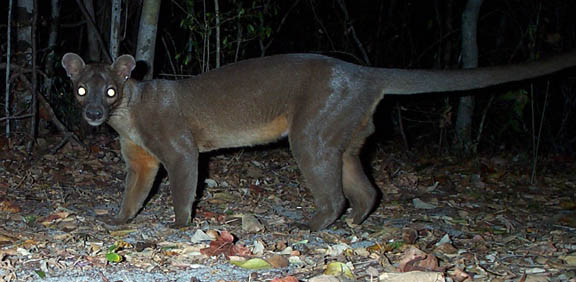
August 10
Some time before we arrived, the radio collar of a particularly large fossa named Caesar had gone stationary. Prior to this, Caesar had apparently been prone to getting himself captured every few days, so his absence was uncharacteristic, but a day or two after his collar stopped moving, a camera trap caught this photo, so Luke figured Caesar had somehow slipped his collar. The image, by the way, is copyright Luke Dollar 2001.

The morning of the 10th, I set off to do a trap check in JBB, checking the traps, resetting any that had closed, and giving the chickens rice and water. I was hoping to come across Caesar, as I'd been told he got recaptured very often. We had no luck, though, and returned to lunch disappointed.
Shortly after our return, the team that had been assigned to search for Caesar's collar returned triumphantly, having finally tracked the damn thing down via radio triangulation. Unfortunately, the collar appeared to have been cut.
This was terrible news. Fossas do not approach humans under any circumstances, so if his collar was cut, that meant it was cut from a corpse. Luke arrived back not long after, and I broke the news and showed him the collar. The way his face fell was just terrible.
Traditionally, if a Malagasy can kill a fossa, he will. This is one of many traditional Malagasy practices that are extremely bad for their ecosystem. However, all the locals knew about Luke's project and had learned that it was a better idea to leave fossas alone. Luke theorized that it might have been strangers wandering through the area. He then spent the rest of the day rather depressed, trying to figure out why the fossa in the camera trap photo had Caesar's markings and unusual size. It was clear that Luke took his work very seriously, and felt very strongly about fossas. We were all rather down in the mouth the remainder of the day.